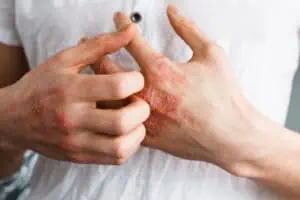
Hand eczema flare-ups are beyond annoying. It can cause redness, itching, cracks, blisters, and dryness to the point of peeling and flaking, but that’s not all.
During a bad flare-up of hand eczema, fingers can swell and hands can hurt. Without proper treatment, hand eczema can become chronic. A severe case could even make it hard to button your clothes or use a computer.
So, what causes flares? Here are five of the most common triggers and tips for avoiding them.
Trigger 1: Exposure to water
Constantly wetting and drying your hands can break down skin’s protective barrier, especially when you have sensitive skin that is prone to dryness. “Even after hands are dried, there’s some water left that evaporates. When it does, it reduces skin’s natural oils,” said Dr. Alissa O’Brien, a dermatologist at Water’s Edge Dermatology. If the water is piping hot, it’s even more irritating and drying.
How to dodge it: For dishwashing and other wet tasks, wear vinyl gloves with a cotton lining (or a separate cotton liner). Latex gloves can cause allergic reactions, so it’s best to avoid them. When you wash your hands, use a mild, low-lathering soap free of fragrances, preservatives, and dyes, and use lukewarm water, not hot. After washing and gently drying your hands, apply moisturizer, preferably an ointment. “Aquaphor Healing Ointment is probably one of the best,” said Dr. O’Brien. Other ointment brands she recommends include Vaseline, Cetaphil, CeraVe, Eucerin, and Aveeno. If you find ointments too greasy to use during the day, use a cream moisturizer instead and an ointment at night, under a pair of cotton gloves.
Trigger 2: Exposure to allergens or irritants
Hand eczema is often caused or worsened by exposure to a substance that’s irritating — think alcohol, bleach, cleansers or solvents — or one that causes an allergic reaction, such as perfume or certain plants. Florists often get dermatitis on their thumb and forefinger when clipping chrysanthemums and tulips (it’s known as “tulip fingers”). In the kitchen, vegetables — particularly garlic and onion — can lead to a flare-up, especially on the fingertips. Even fabric can exacerbate hand eczema. Rough, coarse materials such as wool and stiff synthetics such as polyester can trigger an itch-scratch cycle that worsens the condition.
How to dodge it: Pay attention to what sets off your eczema. “Whether you’re at home or on the job, learn what irritates your skin and avoid or limit contact with those things,” advised Dr. O’Brien. Use a washing machine, dishwasher, and food processor when possible and ask other family members for help with housework, cooking and gardening to give your hands a break. Protect your hands from irritants and allergens by wearing vinyl or cotton gloves while you do chores. Wear heavy-duty vinyl or neoprene gloves at work if you’re exposed to triggers there. If the gloves you have irritate your skin, ask your dermatologist for recommendations.
Trigger 3: Stress
Stress triggers the production of hormones, including cortisol and adrenaline, that can suppress the immune system and cause an inflammatory response in the skin. An eczema flare-up can create even more stress, leading to a vicious cycle. If you’re under a lot of emotional or physical stress, you may be at greater risk of dyshidrotic eczema, a type that causes itchy blisters on the palms of the hands that may be filled with fluid.
How to dodge it: Exercise is an excellent way to manage stress. In addition to boosting the production of feel-good chemicals, it also improves sleep, which can help to further decrease stress. To ease anxiety on the spot, take slow, deep, belly-expanding breaths in through your nose and exhale through your mouth.
Trigger 4: Sweating
Whether you’re walking outside, playing with your kids, or exercising, sweating can irritate the skin. The salty residue that’s left behind after sweat evaporates is known to worsen the itch. Some research suggests that people with eczema are more prone to excessive sweating.
How to dodge it: Keep a towel with you as you work out or when you’re outside to wipe away sweat, and rinse off sweat with lukewarm water afterward to prevent salty build-up. Because wearing gloves, especially waterproof gloves, can make your hands sweat, take them off frequently (every 20 minutes or so) to let your skin cool down.
Trigger 5: Physical wear and tear
Minor hand trauma from tasks like digging in the garden with bare hands can cause hand eczema or make it worse, as can friction from activities like handling large quantities of paper.
How to dodge it: Wear task-appropriate gloves. Cotton and fabric gloves can keep hands clean and protect against abrasions, but they may not be adequate for work with rough or sharp materials. Working with thorny plants, palm fronds or brambles may require leather gloves with longer cuffs.
Avoiding eczema triggers often goes a long way toward managing the condition. The key is to be diligent. “It can take a massive amount of effort if you have severe hand dermatitis, and people often want a quick fix, but putting in that effort to take care of your skin really pays off in keeping eczema from coming back,” said Dr. O’Brien.
Don’t get discouraged: Hand eczema can be stubborn, and it may take a few months for the patches of red, scaly and inflamed skin to fully heal. After that, your eczema is less likely to return.
END
Article Written By: Karyn Repinski, a Brooklyn, NY-based award-winning health and beauty writer.
Medical Review By: Ted Schiff, MD





